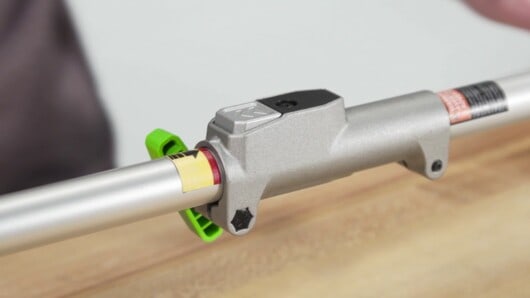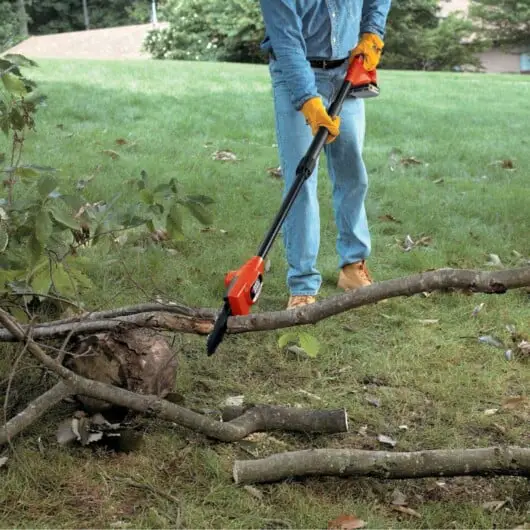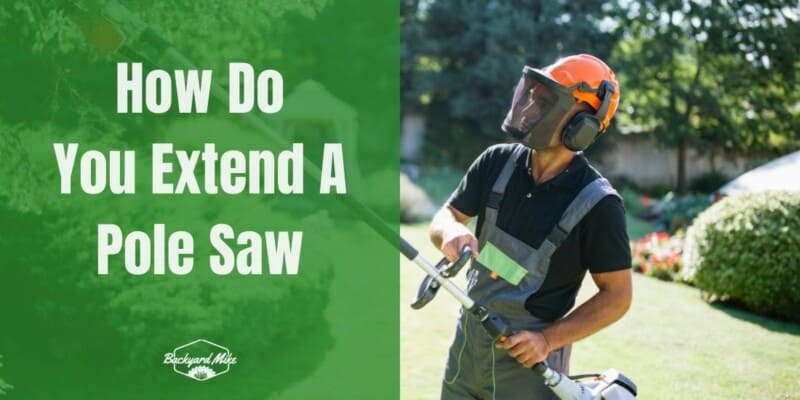Do you own a pole saw, but you’re unsure of the right way to extend it? If yes, then you should be thankful, as you’re in the right place.
Extending a pole saw doesn’t require a lot of experience or expertise. You’ll need to use the pole extension attachment, which will be helpful when cutting, trimming, and pruning tree branches several meters above the ground. You’ll need to attach the extension pole to the saw. Select your preferred cutting head and attach it to the long pole to extend the pole saw.
In this article, you’ll get to know all about understanding your pole saw, how do you extend a pole saw, safety tips to remember when using a pole saw, important tips for using a pole saw, and more. Stick around to know all the answers that you’re looking for.
Extend a pole saw for your backyard use
A pole saw is a relatively dangerous tool to operate. It requires a fair bit of expertise and experience. Interestingly, the majority of the danger when it comes to using a pole saw isn’t actually posed by the pole saw itself. Instead, most of the danger lies in the limbs and branches falling on you after being cut.
If you need to cut, prune, or trim the trees in your house, you should proceed with caution. Regardless of what you’re doing, you should remember that safety will be of utmost importance. An extended pole saw will be beneficial for a wide variety of uses for occasional users. Not everyone has to spend a lot of money on professional models, as your backyard doesn’t require professional cutting.
You can just purchase a gas-powered or battery-powered extended pole chainsaw and carry out several jobs around your backyard. People who have been using gas-operated chainsaws feel reluctant to reach high-to-cut areas as they might become unstable. Chainsaw safety is a concern, and using it overhead shouldn’t be done without a pole extension and at proper angles.
Even with a pole saw, you shouldn’t try cutting limbs and branches over a maximum 60-degree angle with the ground. However, it can be quite tempting to cut on tiptoes and straight up. You shouldn’t do it as the limbs could wind up in your face alongside the moving chain and blade.
Understand your pole saw before extending it
Engine parts of the pole saw
The main operating unit of the pole pruner is known as a powerhead. It looks and works similar to a regular power saw, although it’s slightly smaller. You’ll be having a trigger and a trigger lock while the choke is present on the saw and is needed during cold starts.
The fuel pump bulb will be on the rear, nearby to the pull cord. Every pruner band is different, which is why you should read the operation manual. The gas tank is present near the pump bulb. It must be filled with non-alcohol gas and mixed with high-quality 2-cycle oil in a ratio of 50:1.
Operate the pole pruner
Gas-operated pole pruners are largely used for putting high trimming jobs within your reach. These will give you the needed power and precision for trimming branches down to size. These either have a disconnecting drive tube or a “pole” or one that is capable of extending from within the tube. If you purchase a connecting tube, it could work at a maximum height of around 15 feet.
The prune when intact will have a balanced weight just behind the powerhead of the saw. You should transport the saw in a horizontal position while holding it at the balance point. A smooth cutting operation works off this point after combining with a shoulder strap. As you’re taking down limbs, stand on the ground, and don’t take off too many limbs at once.
You shouldn’t tackle an exceedingly large limb (over 4 inches in diameter) without cutting it into multiple sections. Each section should start off with a small undercut to prevent tearing back and pinching. Follow it with a top crosscut for dropping the section. Once the limb has been felled, flush cut the remaining trunk snag. Cut it to a point where cambium can start growing over and reseal the wound.
Prevent the saw from pinching
It is a given that you’ll pinch your saw’s blade at some point, especially as you’re getting used to the science of limb cutting. Prepare for a pinch by including a handheld pruner in your toolkit. Pinched saws hanging from the tree branches make for a terrible day and much aggravation. Moreover, your tool might also get a broken blade, chain, or pole.
Regular pinched chainsaws come with the advantage of either being on or near the ground. In the worst-case scenario, multiple wedges can get tapped into the cut for releasing the saw. Pole saws could hang in horrible positions with no way of relieving the pinch. Managing the weight and careful placement of cuts will be important.
- Size up the limb’s length and weight and then cut it into manageable sections
- Use a small undercut at the limb drop point before finishing off that section with a top cross-cut
- Learn from your past mistakes
The chain cutting attachment
All that you’ve got attached to the end of your pole saw is a small chain and bar. It is made up of the same parts and attachments as a regular chainsaw. However, it is powered by a drive tube with a splined shaft. The drive tube needs to be properly attached on detachable models, but it isn’t a problem on extending tubes. The detachable poles can just slide and snap, and they’re very easy to manage.

Mounting and tensioning the bar and chain will follow similar rules as regular power saws. The sprocket cover should be removed, and the tensioner adjusted to where your chainsaw pulls off the blade track groove. Sharpening must be done in the same way as a regular saw. The chain oil container comes mounted on the chain cutting attachment. The tank can be located easily, and the filler cap is visible and easily removed for filling. The storage capacity of the automatically applied chain oil will last around half of the tankful of fuel.
How do you extend a pole saw?
Extending a pole saw, regardless of the brand, does not require a lot of experience or expertise. It is actually one of the simplest tasks that you can perform on your pole saw. Even though it’ll likely be explained in your pole saw’s user manual, you can never have too much information.
With your pole saw, you’ll be having a pole extension attachment. This pole will be necessary when you wish to cut, trim, or prune tree branches that are many meters or feet above the ground. You’ll simply have to attach the extension pole to the saw, and you’re almost done.
Choose your preferred cutting/trimming/pruning head and then attach it to the long pole. Make sure that you’re attaching it firmly, and you’ll be good to go. There are many models of a pole saw, and their extension poles can greatly vary in length. However, they all have very similar extension techniques.
How to use the extended pole saw
Once you know how do you extend a pole saw, it’s important to know about the safety considerations to make. You need to understand how dangerous it is to cut or prune trunks that are taller than you. Here is the right way of using an extended pole saw.
1. Find a large working area and clear
Find a large work area below the branches that you’re cutting, and clear away people and property nearby it. Moreover, cordon off this area and keep others from re-entering.
Moreover, clear this area of any trip hazards such as fallen branches while taking note of the ones that cannot be moved, like exposed roots. You should be able to move quickly and safely in the area if something goes wrong.
2. Plan where you’ll be cutting
You need to have a clear plan of where you’ll have to make the cut. Remember that removing a single large branch will usually require many preliminary and jump cuts for reducing the weight before you make the final cut. Try making the cuts at horizontal or almost horizontal surfaces of the vine or branch, if you’ve got the choice.
3. Position the pole saw
With both hands, you should bring the pole saw to a vertical position and then pause to control its weight. Then, reposition to saw to the cutting spot, with the weight resting on the branch.
4. Position yourself properly
Hold the pole saw and move to a place where you’re able to hold your end at chest level. Remember to stand well off to the side of the limb instead of below it. Your pole must be at an angle while you’re cutting and not directly up and down. If the pole is adjustable, you might have to lengthen it to make cutting possible.
5. Start cutting with a starting groove
Make the first couple of strokes slowly and in full control. You should cut perpendicular to the branch such that your first few strokes bite in as much as possible, even if the rest of the cut has to go in a different direction. The idea here is to create a groove in the wood for guiding you later and get faster strokes. On the early strokes, your pole saw will want to slip sideways in case the branch is sloped. If it slips, stop, gather your energy, and then reposition the saw before continuing.

6. Continue and finish the cut
Once the pole saw is securely in the groove, you can increase the stroke speed. Pole saws, similar to pruning saws, cut on the pull stroke and are helped by gravity. Keep your eyes concentrated on the branch, especially when it is about to fall. You should be ready to retreat to safety if needed.
7. Clean up the work area after cutting
Clear the fallen limbs and branches out of the work area before you start the next cut. This way, you won’t end up accidentally tripping and falling.
Safety tips to remember when using an extended pole saw
Read the user manual
Virtually every pole saw comes with its own user manual. Brands like Stihl also provide the user manual in PDF form, and they’re around 70 pages long. A large part of the user manual is meant for providing the necessary safety tips. You must take enough time to read through the user manual of your pole saw before using it. It’ll be in the best interest of not just you, but your tool, as the manual will be full of useful safety and usage tips.
Seek guidance from an expert
If you’re using a pole saw for the first time, it’s advised that you should look for the necessary guidance. You’ll need to keep an expert around you to help you guide through the different steps. After using it under the supervision of an expert 2-3 times, you can start to use it on your own.
Never try to control the pole saw with one hand
You shouldn’t attempt to control your pole saw using just one hand. It’s a powerful tool, and the chances are high that you can lose control when you’re using just one hand. If you aren’t careful, this can lead to a fatal injury. Remember, power without control will be extremely dangerous.
Avoid using the pole saw when it is windy
This is an important tip, as the wind can easily change the trajectory of a part of the tree that you’ve just cut off. You might not even be able to tell how and in which direction the cut trunk will be blown. The wind could easily blow in your direction and make the branches fall on you. This could potentially lead to a serious injury. The branches can even be blown towards the nearby property, parked cars, or windows of buildings nearby. Once it’s windy, you’ll need to stop trimming or cutting. Moreover, it isn’t advisable that you shouldn’t prune or trim trees when it’s raining, either.
Cut just one limb at a time
If you want to avoid any kickbacks, you should be cutting only one limb at a time. Moreover, you shouldn’t be cutting limbs with the nose of the guide bar. You shouldn’t let the nose of the guide bar contact any other object.
Give it some distance
It isn’t enough to just start cutting with a pole saw. You need to consider when the cut branches are falling. You have to stay away from the path of the branches. You wouldn’t want a piece of heavy wood falling on you, as it could easily lead to a serious injury. In the user manual, it’ll be stated that you should have a distance of at least 50 feet or 15 meters from the base of the tree whose limbs you’re looking to cut. This way, the cut limb will not drop on you or close to you.
For the same reason, it is advised that you should be wearing goggles. Remember, you will be looking up as you’re cutting, pruning, or trimming. These activities expose your eyes to dirt, debris, and dust. Moreover, ensure that no one is around the place Your pets and kids should also be kept away from the work area.
Avoid power lines
You should avoid trimming trees and falling branches near power lines or other power facilities. The pole saw isn’t actually resistant to electricity. It can come in contact with a naked wire when you’re using it. If you are not careful, you can end up electrocuting yourself.
Change your blade on time
Once you start noticing that the blade of any of the cutting heads is getting dull, it’ll be better to change it immediately. The sharper your pole saw’s blade, the faster the pole saw will cut. Dull blades will slow you down and affect the pole saw’s performance.
Conclusion
Thank you for reading. Hopefully, now you know a lot more about understanding your pole saw, how do you extend a pole saw, safety tips to remember when using a pole saw, important tips for using a pole saw, and more. If you use a pole saw, you should know that extending a pole saw doesn’t actually require a lot of skills and experience. You’ll need to use the pole extension attachment, which will be useful when cutting, trimming, and pruning tree branches several meters above the ground. You’ll need to attach the extension pole to the saw. Select your preferred cutting head and attach it to the long pole to extend the pole saw.


